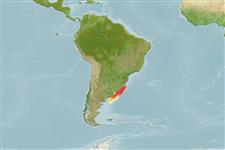>
Eupercaria/misc (Various families in series Eupercaria) >
Sciaenidae (Drums or croakers)
Etymology: Umbrina: Latin, umbra, -ae = shadow, in the sense of phantom; due to its quick movements (Ref. 45335).
Environment: milieu / climate zone / depth range / distribution range
Écologie
marin; saumâtre démersal; océanodrome (Ref. 51243); profondeur ? - 200 m (Ref. 47377), usually 10 - 100 m (Ref. 27363). Subtropical; 31°S - 42°S, 62°W - 49°W (Ref. 54933)
Southwest Atlantic: Cabo de São Tomé, Rio de Janeiro, Brazil to Bonaerensis, Argentina.
Length at first maturity / Taille / Poids / Âge
Maturity: Lm 15.9, range 17 - ? cm
Max length : 53.3 cm TL mâle / non sexé; (Ref. 39376); common length : 37.0 cm TL mâle / non sexé; (Ref. 7025); âge max. reporté: 26 années (Ref. 7025)
Description synthétique
Morphologie | Morphométrie
Épines dorsales (Total): 11; Rayons mous dorsaux (Total): 21-25; Épines anales 2; Rayons mous anaux: 7 - 8. Upper part of body with many dark longitudinal stripes; no well defined dark spots at bases of pectoral fins (Ref. 27363).
Especially abundant at about 100 m depth (Ref. 27363). Found over sand and mud bottoms (Ref. 47377).
Life cycle and mating behavior
Maturité | Reproduction | Frai | Œufs | Fécondité | Larves
Haimovici, M., 1988. Cohort analysis on the Argentine croaker (Umbrina canosai) exploited in South Brazil, Uruguay and Argentina. Publ. Com. Tec. Mixta Frente Marit. Argent. Urug. 4:33-40. (Ref. 7415)
Statut dans la liste rouge de l'IUCN (Ref. 130435)
Menace pour l'homme
Harmless
Utilisations par l'homme
Pêcheries: hautement commercial
Plus d'informations
RéférencesAquacultureProfil d'aquacultureSouchesGénétiqueElectrophoresesHéritabilitéPathologiesTraitementNutrientsMass conversion
CollaborateursImagesStamps, Coins Misc.SonsCiguateraVitesseType de nageSurface branchialeOtolithesCerveauxVision
Outils
Articles particuliers
Télécharger en XML
Sources Internet
Estimates based on models
Preferred temperature (Ref.
123201): 8 - 19.8, mean 14.8 °C (based on 242 cells).
Phylogenetic diversity index (Ref.
82804): PD
50 = 0.5000 [Uniqueness, from 0.5 = low to 2.0 = high].
Bayesian length-weight: a=0.00891 (0.00728 - 0.01090), b=3.08 (3.06 - 3.10), in cm total length, based on LWR estimates for this species (Ref.
93245).
Niveau trophique (Ref.
69278): 3.9 ±0.57 se; based on food items.
Résilience (Ref.
120179): Milieu, temps minimum de doublement de population : 1,4 à 4,4 années (K=0.26-0.27).
Fishing Vulnerability (Ref.
59153): Low to moderate vulnerability (32 of 100).
Climate Vulnerability (Ref.
125649): Moderate to high vulnerability (49 of 100).
Nutrients (Ref.
124155): Calcium = 87.1 [46.8, 175.5] mg/100g; Iron = 1.14 [0.60, 2.03] mg/100g; Protein = 19.7 [18.6, 20.8] %; Omega3 = 0.415 [0.243, 0.670] g/100g; Selenium = 28.3 [14.6, 54.5] μg/100g; VitaminA = 18.5 [6.5, 62.6] μg/100g; Zinc = 0.746 [0.523, 1.092] mg/100g (wet weight);
